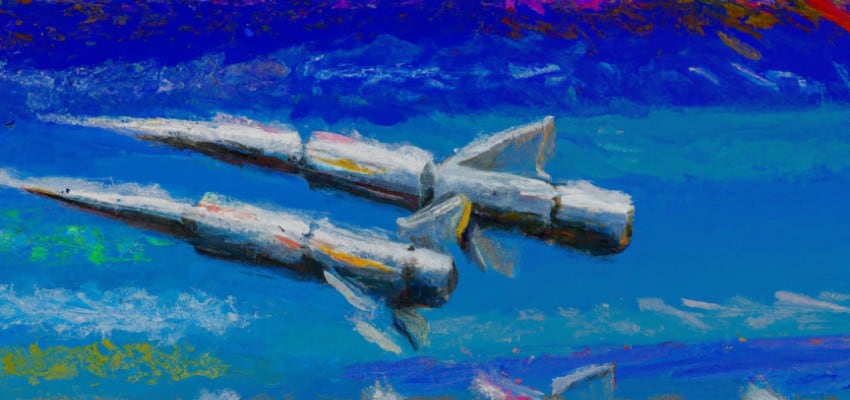|
|
Content Assessment: Bridges and Missile Strikes? Ukraine Conflict Assessments in Maps (October 7 - 11, 2022)
Information - 94%
Insight - 95%
Relevance - 93%
Objectivity - 95%
Authority - 96%
95%
Excellent
A short percentage-based assessment of the qualitative benefit of the post highlighting the recent Ukraine conflict assessments in maps from the Institute for the Study of War.
Editor’s Note: One of the most accurate and detailed sources for ongoing updates on the Ukraine crisis is the Ukraine Conflict Update from the Institute for the Study of War. The Institute for the Study of War (ISW) is a 501(c)(3) organization and produces strictly non-partisan, non-ideological, fact-based research. ISW seeks to promote an informed understanding of war and military affairs through comprehensive, independent, and accessible open-source research and analysis. ISW’s research is made available to the general public, military practitioners, policymakers, and media members. Providing a daily synthesis of key events related to the Russian aggression against Ukraine, ISW updates may benefit cybersecurity, information governance, and legal discovery professionals as they follow the business, information technology, and legal trends and trajectories impacted by and stemming from the current Ukraine conflict.
Assessment and Maps*
Ukraine Conflict Assessments – An Overview in Maps
- Institute for the Study of War (ISW), Russia Team
- Critical Threats Project (CTP), American Enterprise Institute
General Assessment Background Info
- ISW systematically publishes Russian campaign assessments that include maps highlighting the assessed control of terrain in Ukraine and main Russian maneuver axes.
- These maps augment daily synthetic products that cover key events related to renewed Russian aggression against Ukraine.
The Russian Offensive Campaign Assessments
- October 11, 2022
- By Karolina Hird, George Barros, Kateryna Stepanenko, Grace Mappes, Riley Bailey, and Frederick W. Kagan
Key Development
- Russian forces conducted massive missile strikes across Ukraine for the second day in a row on October 11. The Ukrainian General Staff stated that Russian forces fired nearly 30 Kh-101 and Kh-55 cruise missiles from Tu-95 and Tu-160 strategic bombers and damaged critical infrastructure in Lviv, Vinnytsia, Dnipropetrovsk, Donetsk, and Zaporizhia oblasts.
Key Takeaways
- Russian forces conducted massive missile strikes across Ukraine for the second day in a row.
- Army General Sergey Surovikin’s previous experience as commander of Russian Armed Forces in Syria is likely unrelated to the massive wave of missile strikes across Ukraine over the past few days, nor does it signal a change in the trajectory of Russian capabilities or strategy in Ukraine.
- The Russian Federation is likely extracting ammunition and other materiel from Belarusian storage bases, which is incompatible with the notion that Russian forces are setting conditions for a ground attack against Ukraine from Belarus.
- Russian sources claimed that Ukrainian forces continued to conduct counteroffensives east of the Oskil River and in the direction of Kreminna-Svatove.
- Russian sources claimed that Ukrainian troops continued ground attacks in northern and western Kherson Oblast.
- Ukrainian forces are continuing an interdiction campaign to target Russian military, technical, and logistics assets and concentration areas in Kherson Oblast.
- Russian forces continued to conduct ground assaults in Donetsk Oblast.
- Russian reporting of explosions in Dzhankoy, Crimea, indicated panic over losing further logistics capabilities in Crimea following the Kerch Strait Bridge explosion.
- Russian federal subjects are announcing new extensions and phases of mobilization in select regions, which may indicate that they have not met their mobilization quotas.
- Russian and occupation administration officials continue to conduct filtration activities in Russian-occupied territories.
- October 10, 2022
- By Kateryna Stepanenko, George Barros, Riley Bailey, Angela Howard, and Frederick W. Kagan
Key Development
- Russian forces conducted a massive missile strike attack against over 20 cities, including Kyiv, on October 10. The Ukrainian General Staff reported that Russian forces launched over 84 cruise missiles and 24 drone attacks, 13 of which were carried out with Iranian-made Shahed-136 drones.
Key Takeaways
- Russian forces conducted massive, coordinated missile strikes on over 20 Ukrainian cities.
- President Vladimir Putin claimed that the coordinated missile strikes were in retaliation for the explosion on the Kerch Strait Bridge, likely in part to curry favor with “pro-war” factions.
- Russian and Belarusian ground forces remain unlikely to attack Ukraine from Belarusian territory to the north.
- Ukrainian forces have likely liberated over 200 square kilometers of territory in western Luhansk Oblast as of October 10.
- Russian forces continued unsuccessful attempts to regain recently lost territory in northwest Kherson Oblast while reinforcing nearby positions with damaged and hastily mobilized units.
- Russian forces continued ground attacks in Donetsk Oblast.
- Russian and occupation administration officials are setting conditions to move up to 40,000 residents out of Kherson Oblast to Russian-occupied Crimea and the Russian Federation.
- Russian forces cannot supply mobilized forces, likely due to years of supply theft by contract soldiers and commanders.
- October 9, 2022
- By Kateryna Stepanenko and Frederick W. Kagan
Key Development
- The attack on the Kerch Strait Bridge, coupled with recent Russian military failures and partial mobilization, is generating direct criticism of Russian President Vladimir Putin and the Kremlin from the Russian pro-war nationalist community.
Key Takeaways
- Ukrainian forces continued to advance east of the Oskil Rver in the direction of Luhansk Oblast and have entered Stel’makhivka (about 18km west of Svatove). Russian forces launched unsuccessful assaults on Burdaka on the Kharkiv Oblast-Russian border, and Terny northeast of Lyman.
- Russian sources reported that Russian forces attempted to attack in the direction of Ternovi Pody (approximately 30km northwest of Kherson City) Ukrainian sources reported that Russian forces continued to target newly liberated settlements in northern Kherson Oblast with artillery, MLRS, and aviation.
- Ukrainian sources reported that Ukrainian forces repelled over 30 attacks in the Bakhmut and Avdiivka areas. Russian forces launched an unsuccessful assault southwest of Donetsk City.
- Russian forces targeted residential areas of Zaporizhzhia City with cruise missiles.
- A Russian milblogger accused North Ossetia and Vladikavkaz of failing to fulfill mobilization orders due to carelessness and the personal interests of regional officials.
- Ukrainian sources reported that Russian occupation authorities are moving their families from Kherson Oblast to Crimea, and from Starobilsk to Luhansk City.
- October 8, 2022
- By Kateryna Stepanenko, Riley Bailey, Angela Howard, Grace Mappes, and Frederick W. Kagan
Key Development
- A large-scale explosion damaged the Kerch Strait Bridge that links occupied Crimea with Russia on October 8. Maxar satellite imagery shows that the explosion collapsed one lane of the road bridge and damaged the nearby railway track.
Key Takeaways
- A large-scale explosion seriously damaged the Kerch Strait Bridge that links occupied Crimea with Russia.
- The Kremlin named the Russian Commander of the Aerospace Forces, Army General Sergey Surovikin, the new commander of the Russian operation in Ukraine, and this appointment has generated positive feedback within the nationalist community.
- Russian sources claimed that Ukrainian forces continued counteroffensive operations in Kharkiv and Luhansk Oblasts.
- Russian forces continued establishing defensive positions in northern Kherson Oblast.
- Russian forces continued to attack settlements around Bakhmut, Avdiivka, and west of Donetsk City.
- Ukrainian forces reportedly continued to shoot down Iranian-made Shahed-136 drones.
- Russian federal subjects are facing financial challenges in funding mobilization.
- Russian and occupation administration officials continued measures to remove Ukrainian children from their homes in Russian-occupied territories.
- October 7, 2022
- By Kateryna Stepanenko, Katherine Lawlor, Grace Mappes, and Frederick W. Kagan
Key Development
- Western and Russian reports of fractures within the Kremlin are gaining traction within the Russian information space, undermining the appearance of stability of Russian President Vladimir Putin’s regime.
Key Takeaways
- Western and Russian reports of fractures within the Kremlin are gaining traction within the Russian information space, undermining the appearance of stability of Russian President Vladimir Putin’s regime.
- Russian President Vladimir Putin may have waited to announce that he had replaced Eastern Military District (EMD) Commander Aleksandr Chaiko until he needed to use Chaiko as a scapegoat for Russian military failures in Kharkiv Oblast and Lyman, Donetsk Oblast.
- Ukrainian forces likely continued counteroffensive operations along the Kreminna-Svatove road in western Luhansk Oblast.
- Russian forces continued to establish defensive positions in northern Kherson Oblast, and Ukrainian and Russian sources reported ongoing battles north and northwest of Kherson City.
- Russian forces continued ground attacks in Donetsk Oblast.
- Anecdotal reports of poor conditions for mobilized personnel in the Russian information space are continuing to fuel the accurate narrative of Kremlin and Russian Ministry of Defense (MoD) incompetence.
- Russian officials offered basic concessions for mobilized men and their families on October 7 but continue to rely on local governments and other non-federal institutions to provide support, including food and training, to newly mobilized men.
- Russian occupation authorities in Donetsk Oblast are continuing to forcibly mobilize Ukrainian civilians, belying Russian claims that residents of newly-annexed territories will not be mobilized.
- Ukrainian officials in newly liberated Kharkiv Oblast continue to uncover Russian torture chambers and other human rights abuses.
- Russian occupation officials have likely failed to repair necessary civilian infrastructure in occupied and illegally-annexed parts of Ukraine in time for winter as temperatures drop.
We do not report in detail on Russian war crimes because those activities are well-covered in Western media and do not directly affect the military operations we are assessing and forecasting. We will continue to evaluate and report on the effects of these criminal activities on the Ukrainian military and population and specifically on combat in Ukrainian urban areas. We utterly condemn these Russian violations of the laws of armed conflict, Geneva Conventions, and humanity even though we do not describe them in these reports.
Chronology of Maps from October 7 – 11, 2022 – Mouseover to Scroll
Ukraine Conflict Maps - 100722-101122See the Institute for the Study of War Interactive Map of the Russian Invasion
Read the latest Ukraine Conflict updates from the Institute for the Study of War
* Shared with direct express permission from the Institute for the Study of War (ISW).
About the Institute for the Study of War Research Methodology
ISW’s research methodology relies on both primary and secondary sources, enabling researchers to develop a comprehensive understanding of the situation on the ground. In order to analyze military and political developments in any given area, ISW’s research analysts must wholly understand the systems of enemy and friendly forces. They must also understand the population demographics, physical terrain, politics, and history of that area. This lays the analytical foundation for understanding the reasons for particular developments and fulfilling their assigned research objectives. ISW analysts also spend time in places like Iraq, Afghanistan, and elsewhere in order to gain a better understanding of the security and political situation and to evaluate the implementation of current strategies and policies. Our researchers compile data and analyze trends, producing a granular analysis of developments in areas of research, producing an accurate, high-resolution, timely, and thorough picture of the situation. ISW’s research methodology guarantees its success and commitment to improving the nation’s ability to execute military operations, achieve strategic objectives, and respond to emerging problems that may require the use of American military power.
About the Institute for the Study of War
The Institute for the Study of War advances an informed understanding of military affairs through reliable research, trusted analysis, and innovative education. We are committed to improving the nation’s ability to execute military operations and respond to emerging threats in order to achieve U.S. strategic objectives. ISW is a non-partisan, non-profit, public policy research organization.
Learn more, get involved, and contribute today.
Additional Reading
- [Annual Update] International Cyber Law in Practice: Interactive Toolkit
- Data Embassies: Sovereignty, Security, and Continuity for Nation-States
Source: ComplexDiscovery
























